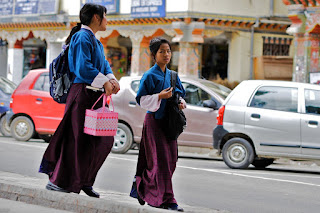 Traveling in Bhutan means unpredictable (unavailable in my case) internet service. None the less, I am back in the Western half of the country now, making preparations to leave.
Traveling in Bhutan means unpredictable (unavailable in my case) internet service. None the less, I am back in the Western half of the country now, making preparations to leave.In the valley of "Ura" I visited a small monastery. The monks were attending a special ceremony up the road where a higher up lama was giving blessings, so we had a little time to kill until they returned. While we waited, my guide informed me that the people in this part of the country are renowned for their generosity.
This friendly woman approached and offered us all kinds of things including "ara." I had heard about this stuff by way of signs in the hospital warning of the dangers of alcoholism. Ara is home brewed alcohol, true Bhutanese moonshine. Now notice the size of the thermos next to this woman. It was full. Enough to flatten the entire town. Bhutanese liken ara to Japanese sake.

Well, when in Bhutan....She offers up a bowl about like what you might eat won-ton soup out of in a Chinese cafe. Holding it out, she proceeds to fill it to the brim. I take a sip and then perform an act of head and neck acrobatics, simultaneously suppressing my gag reflex, while smiling at the woman, nodding and bowing in thanks, and looking around for an escape to this predicament. And then the nausea hit as this poison reached my stomach. I was then informed by my guide that it is customary to always accept a second portion of anything offered, regardless of how small it may be, even a few drops more (I'm not kidding about this). This woman proceeded to fill my bowl up again overflowing the rim this time.
Thank God (or Buddha as the case may be) for photography. You see, I had my camera with me and almost without thinking, I grabbed it from the ledge on which it sat, brought it up to my eye, started snapping as I chased after some children running around the corner. As soon as I was out of sight I accidentally spilled my entire bowl of this wicked potion into a rain puddle. Phew.

Here is my guide Pema standing by "The Burning Lake."
Here is my driver Hamraj and our van.

We all know that these dzongs and monasteries I have shown pictures of were built hundreds of years ago, in the 7th. and 8th. centuries. Remarkable how they have stood the test of time with little in the way of restoration. Now, unless I'm mistaken, there was no running water back then. So I would like to conclude by answering that question burning in everyone's mind, "where do the monks bathe?"
So that's all for now. See you back in the states.













































